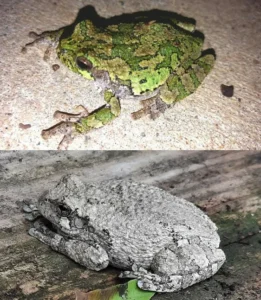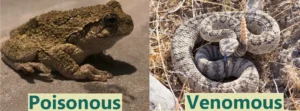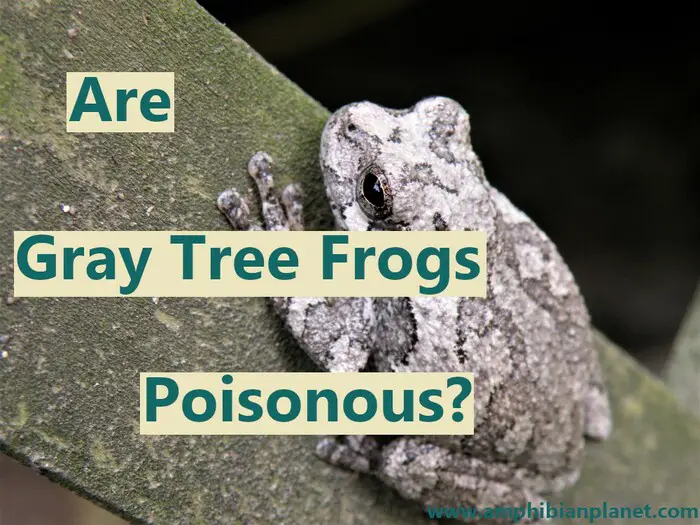Gray tree frogs are fairly large tree frogs ( 1 – 2 inches in length) with rough, warty skin. Despite their name, not all gray tree frogs are actually gray. They vary in coloration from mottled gray or brownish-gray to light green, but their color can change depending on their environment. But are gray tree frogs poisonous?
Gray tree frogs are mildly poisonous. When threatened, they produce noxious skin secretions that make them taste bad to many would-be predators. These secretions are merely irritating when ingested by a human, but can make some small animals such as dogs (especially small or sickly dogs), or cats sick.
Despite their toxic skin secretions, gray tree frogs are usually harmless to humans. The secretions they produce are only harmful when ingested (such as when you handle a gray tree frog with your bare hands, then rub your eyes before washing your hands).
When left alone or when handled with a few safety precautions in mind, gray tree frogs are harmless creatures.
Gray Tree Frogs Are Only Mildly Poisonous
These toxic secretions are also thought to have the added benefit of preventing some bacterial and fungal infections. Since frogs breathe through their skin (in addition to their lungs), a skin infection can disrupt their respiration and prove to be fatal.
“Gray Tree Frogs” Are Actually Two Species
There are two species of gray tree frog; the eastern gray tree frog (Hyla versicolor), sometimes called the northern or common gray tree frog – and the cope’s gray tree frog (Hyla chrysoscelis).
These two frogs are sibling species and are so similar that they appear identical. They both have rough skin with a bumpy texture and large, prominent toe pads on their fingers and toes that help them cling to tree bark and other surfaces.

Their coloration varies from green to light greenish gray, gray, brown, or dark brown with irregular dark blotches on the back. However, their color can change depending on their environment and activity (they tend to be more greenish during the breeding season).
These frogs usually have a light spot beneath the eye and the skin on their inner thigh is bright yellow or orange, which is most visible when the frog is jumping or moving.
Since these two frog species are visually identical, the main way to tell them apart (besides genetic testing) is by their call; the call of the eastern gray tree frog is a melodic birdlike trill while the call of Cope’s gray tree frog is a rapid high-pitched buzzing trill.
Of these two gray tree frog species, only the Cope’s gray tree frog is known to be poisonous. However, since these two species are visually identical and very difficult for the average person to tell apart, it is a good idea to treat all gray tree frogs that you come across as potentially poisonous.
Gray Tree Frogs Are Not Venomous
If you are like most people, you have used the words ‘poisonous’ and ‘venomous’ interchangeably. However, you should know that there are significant differences between the two terms.
Most poisonous animals are not venomous, and most venomous animals are not poisonous. Confused?
To make things simple:
- If an animal has to bite or sting you to inject its toxins, it is venomous.
- If an animal secretes its toxins outside of its body, and you absorb the toxins when you come in contact with the animal, it is poisonous.
In other words, Venom is actively injected, usually through stings, fangs, or barbs (think rattlesnakes, scorpions). Poison on the other hand is delivered much more passively and has to be absorbed/ingested into your body.
It can be ingested when it comes into contact with your eyes, lips, the mucus lining of the nose, or open cuts on your skin (think poison dart frogs).

Gray tree frogs secrete toxins on their skin to stop predators from eating them but cannot actively inject these toxins into a predator. This means they are poisonous, but not venomous.
Poisonous animals are typically not aggressive and are usually harmless if you don’t touch them or otherwise come in contact with their toxin. They only use their toxin to deter animals from trying to eat them.
Are Gray Tree Frogs Dangerous to Humans?
Although poisonous, gray tree frogs typically aren’t dangerous to humans. The toxin they secrete isn’t potent enough to be of any serious harm to humans. Granted, it may cause irritation or discomfort, but only if you ingest it.
The toxin is not absorbed through your skin but can be absorbed through breaks or cuts on the skin, and the mucous membranes in your eyes, nose, or mouth.
This can happen when you pick up a gray tree frog with your bare hands, then rub your eyes, or stick your fingers in your nose or mouth without first washing your hands.
Doing this would enable the toxin to be absorbed by your mucus membranes and likely lead to severe irritation and general discomfort.
If the toxin comes in contact with your eyes, you may get a very painful burning and itching sensation, somewhat similar to the feeling you get when chili gets in your eye. It may even cause inflammation in the mucous membranes of your eyes.
You can also ingest the secretions when you handle a gray tree frog with open cuts or scratches on your hands. This would most likely lead to an intense burning sensation and a feeling of numbness at the point of contact.
For this reason, it is a good idea to avoid handling gray tree frogs. Although their poison is not lethal when ingested by humans, it can still be severely irritating, particularly when it comes in contact with your eyes.
If you ever need to handle a gray tree frog, remember to avoid touching your eyes, nose, or mouth until you have washed your hands.
Toxins Aren’t the Only Thing to Worry About
The other concern with gray tree frogs is that; like most amphibians, they often carry salmonella bacteria, and while not all do, you shouldn’t take the chance.

Gray tree frogs can carry salmonella bacteria in their digestive tract and excrete it in their waste. The bacteria usually do not cause any illness in the frog – so a gray tree frog carrying salmonella bacteria can look very clean and healthy, but the bacteria can be transmitted to humans.
You can be exposed to salmonella by direct or indirect contact with a frog, it is waste or anything the frog came in contact with. (For example, if you touch a gray tree frog, its droppings or water where the frog has been, then touch stick your fingers into your mouth without first washing your hands).
Exposure to salmonella can cause an infection called Salmonellosis which is characterized by stomach cramps, diarrhea, fever, nausea, and sometimes vomiting.
The infection is usually mild and non-life-threatening – but in some cases, the bacteria can get into the bloodstream leading to serious illness.
Fortunately, merely touching a gray tree frog will not give you a salmonella infection. The bacteria can only cause illness when they are ingested.
Therefore, thoroughly washing your hands immediately after touching a gray tree frog should keep you out of harm’s way
Are Gray Tree Frogs Dangerous to Dogs or Cats?
Since gray tree frogs secrete a toxin when threatened; a dog, cat, or any other pet that attacks one will likely get a mouthful of bitter toxin and let go right away.
If a dog ingests enough of this toxin, it may drool, spit, or even foam at the mouth, but usually nothing more. However, some small or old/sickly dogs could fall sick, especially if they ingest and swallow significant quantities of this toxin.
Fortunately, there are no documented deaths or serious injuries of pets that have attacked or tried to eat a gray tree frog.
Still, it’s best to keep your dogs, cats, or any other pets away from gray tree frogs (and any other frogs) if you can.
Although only mildly poisonous, their secretion is still strong enough seriously irritate a dog (especially small dogs) or cat.
Frogs Can Carry Parasites
As earlier mentioned, frogs can carry salmonella bacteria so a dog or cat that mouths, bites, or eats a gray tree frog may ingest the bacteria and develop an infection.
Additionally, frogs are known to carry tapeworms and other parasites. This means if a dog eats a gray tree frog, it is not only at risk of poisoning but may also consume parasites and develop a parasitic infection.
For this reason, it is important to keep your pets away from gray tree frogs (or any other frogs). If you have captive gray tree frogs at home, keep them in a secure enclosure so they do not come in contact with any of your other pets.
Safety Precautions to Take When Handling Gray Tree Frogs
Generally, it is not a good idea to handle amphibians. This is because they have highly permeable skin that they use to breathe and also absorb moisture from their environments.
Their skin does not just absorb oxygen and moisture though, anything that comes in contact with the skin can be absorbed; including oils, salts, perfumes, lotions, soap, insect repellents, and other substances on your hands.
Handling a gray tree frog with unclean hands can harm and even potentially kill the frog if any harmful substances you may have on your hands make their way into its body.
For this reason, it’s advisable to observe frogs from a distance without physically touching them.
If you ever need to handle a gray tree frog (such as moving it out of harm’s way), take the following precautions to protect both you and the animal.
Before Handling
- Wash your hands EXTREMELY so they are very clean. Not just clean from dirt, but from perfumes, lotions, or any other substances that could harm the frog, and be sure that no soap residue remains on your hands.
- After washing your hands, dry them (preferably with paper towels), then re-moisten with dechlorinated water.
Even better, you could wear protective gloves (powder-free vinyl gloves or nitrile gloves).
Wearing gloves will not only prevent you from coming in contact with toxins and bacteria that may be on the frogs’ skin but will also protect the frog from harmful substances you may have on your hands.
The gloves also have to be moistened with dechlorinated water.
When Handling
- Keep the frog away from your eyes nose and mouth and, be very careful not to touch your eyes, nose, or mouth.
- As you handle the frog, do it very gently and with care so you do not injure or stress the frog in any way. Frogs and other amphibians only secrete their toxin to defend themselves when they feel threatened. Therefore, stressing a gray frog will make it secret it is toxins all over your hands.
Frogs should only be handled for a short time. Handling a frog too long can cause stress to the animal and dry out it is skin.
What to Do After Handling
- Very thoroughly wash your hands with anti-bacterial soap under running water.
Even if you were wearing gloves, it is still a good idea to go the extra mile by washing your hands. As earlier mentioned, gray tree frogs secrete toxins and may carry bacteria that can be harmful, so it’s best to protect yourself.
Before washing your hands, do not touch anything, especially not your eyes, and do not put anything in your mouth.
Frequently Asked Questions (FAQS)
Are gray tree frogs poisonous to touch? Gray tree frogs are indeed poisonous to touch. Remember, they secrete toxins all over their skin, and you can ingest these toxins if you do not wash your hands after touching a gray tree frog.
Are gray tree frogs poisonous to dogs? Gray tree frogs produce noxious skin secretions that are poisonous when ingested by a dog. This means if your dog eats, licks, or bites a gray tree frog, it may ingest toxic secretions. These secretions are merely irritating, and won’t kill or seriously harm most dogs.
Are gray tree frogs poisonous to cats? Since gray tree frogs produce toxic skin secretions, they can be poisonous to cats. The secretions produced by gray tree frogs are not lethally toxic, so they may irritate but won’t kill or seriously harm most cats.
Do gray tree frogs bite? Gray tree frogs can bite, but this is very rare. They will only nip at a human if they are being handled in a way that causes them a lot of stress. Their bite is nothing to be worried about because it is unlikely to hurt and is not venomous or anything of that nature.
Final Thoughts
Gray tree frogs are interesting amphibians that are fun to observe. Although they produce toxic skin secretions to defend themselves, these secretions are unlikely to cause serious harm.
Most people harmed by gray tree frogs (or any other toxic amphibians) are those who handle them with their bare hands, then rub their eyes or put their fingers in their mouth, or nose without first washing their hands.
Doing this enables the toxins to come in contact with the mucous membranes in the eyes or mouth – leading to irritation or discomfort, but usually nothing more.
When left alone (or when handled with care), gray tree frogs are harmless creatures.


